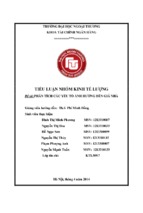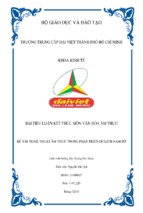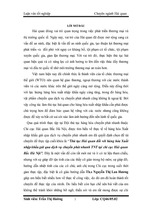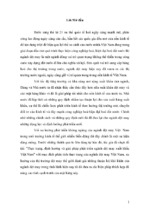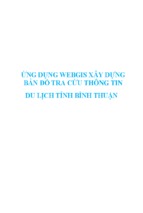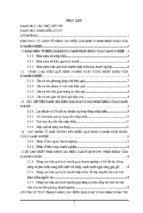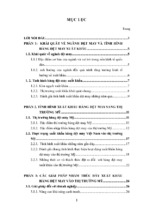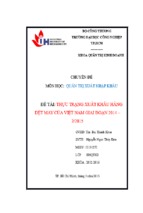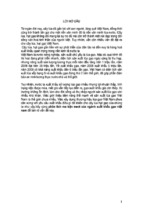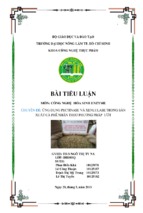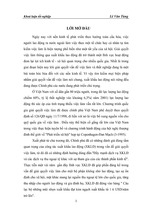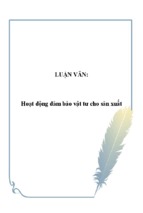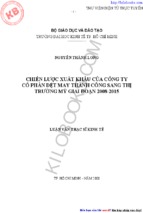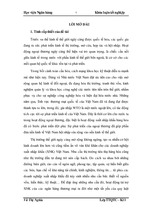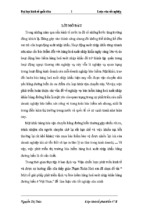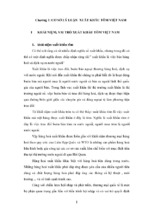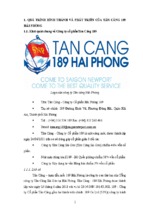iii
ACKNOWLEDGEMENTS
We, firstly, would like to express our gratitude to all of those who have given us the
possibility to complete this thesis. Especially, I would like to express my profound
gratitude and great appreciation to my supervisor Dr. Le Thanh Long for his valuable
guidance, advice and encouragement throughout the research study.
Special thanks are extended to my colleagues in Monsanto Vietnam for their attention and
giving valuable information, materials needed to improve the content of this study. Taking
this opportunity, I would also like to give my special thanks all professors, staff from both
Hochiminh City Open University, and Solvay Brussels School. Moreover, I would like to
thanks my classmates, Solvay Vietnam Alumni for their assistance and co-operation during
my study of the Master in Business and Marketing Management.
Finally, my gratefulness to my beloved family, friends for supporting me to complete the
master course.
Ngo Lanh
15 December, 2010
iv
TUTOR’S COMMENTS
v
TABLE OF CONTENTS
Content
PAGE
Title Page ........................................................................................................................... i
Commitment ....................................................................................................................... ii
Acknowledgements ............................................................................................................ iii
Tutor’s comments ............................................................................................................... iv
Table of Contents ............................................................................................................... v
Abbreviations ..................................................................................................................... vii
List of Figures and Tables .................................................................................................. viii
Executive summary ........................................................................................................... ix
CHAPTER 1. INTRODUCTION ..................................................................................... 1
1.1 Rationales of the project............................................................................................... 1
1.2 The objective of the project ......................................................................................... 3
1.3 Scope of the project ...................................................................................................... 3
1.4 Limitation of the project ............................................................................................... 3
15. Research outline .......................................................................................................... 3
CHAPTER 2. LITTERATURE VIEW............................................................................ 4
CHAPTER 3. RESEARCH DESIGN .............................................................................. 7
3.1 Assumptions ................................................................................................................. 7
3.2 Research objectivities .................................................................................................. 7
3.3 Metholodogy ................................................................................................................ 7
3.4 Findings ....................................................................................................................... 8
CHAPTER 4. STITUATIONAL ANALYSIS .................................................................. 9
4.1 External analysis .......................................................................................................... 9
4.1.1 General information .................................................................................................. 9
4.1.2 Macro environment (PEST analysis) ........................................................................13
vi
4.1.3 Micro environment (Poter’s 5 forces analysis).........................................................16
4.1.4 Summary of opportunities and threats ......................................................................19
4.2 Internal analysis ..........................................................................................................19
4.2.1 The company introduction ........................................................................................19
4.2.2 Summary of strengths and weaknesses ....................................................................25
4.3 SOWT analysis ............................................................................................................25
CHAPTER 5. MARKETING STRATEGIES ................................................................26
5.1 Marketing objectives ...................................................................................................26
5.2 Segmenting ..................................................................................................................27
5.3 Targeting .....................................................................................................................28
5.4 Characteristics of customers ........................................................................................28
5.5 Positioning ...................................................................................................................29
5.6 Marketing mix .............................................................................................................29
5.7 Budgeting ....................................................................................................................38
5.8 Implementation and control .........................................................................................39
CHAPTER 6. CONCLUSION AND RECOMMENDATION .......................................42
REFERENCES
APPENDICES
Appendix 1: Discussion guide for in-depth interview and group discussion ................... A.1
Appendix 2: Questionnaires for market research ............................................................ A.3
Appendix 3: Research findings (corn growers’ concern about their current weeding)….A.6
Appendix 1: Some pictures of the product system &samples of promotional activities . A.9
vii
LIST OF ABBREVIATIONS
ABBREVIATIONS
MEANING
COGs
Cost of Goods sold
DAP
Day after planting
EBIT
Earn before income tax
FAO
Food and Agriculture Organization
FAB
Features, Advantages, Benefits
FY
Fiscal year
GMO
genetically modified organism
GRC
Glyphosate resistant corn
ISAAA
International Service for the Acquisition of Agri-Biotech
Applications
KPI
Key performance indicator
KSF
Key success factor
NSC
None standard cost
P&L
Profit and Lost
R&D
Research and Development
RR
Roundup Ready
RRC
Roundup Ready Corn
PPP
Public-private partnership
SGA
Sales & General Administration
SWOT
Strength, Weakness, Opportunity and Threat
US
The United State of America
USD
US Dollar
USDA
United State Department of Agriculture
VND
Vietnam Dong;
MT: Metric Ton
viii
LIST OF FIGURES AND TABLES
FIGURES
PAGE
Figure 3.1: Weed management methods in Vietnam ......................................................... 8
Figure 4.1: Global area of biotech crops, 1996-2009 ......................................................... 11
Figure 4.2: Vietnam corn planted area, 2000-2009 ............................................................ 12
Figure 4.3: Porter’s 5 forces ............................................................................................... 17
Figure 4.4: Market share of conventional hybrid corn seeds ............................................ 19
Figure 4.5: Monsanto sales growth, FY’2006- 2010 ......................................................... 22
Figure 4.6: The company portfolio ..................................................................................... 24
Figure 4.7: The current organizational chart ...................................................................... 24
Figure 5.1: Levitt’s Total product concept ......................................................................... 29
Figure 5.2: Product distribution flow chart ......................................................................... 34
Figure 5.3: Sales and marketing organizational chart 2011 ............................................... 41
TABLES
PAGE
Table 3.1 Weed concern of corn growers ......................................................................... 8
Table 4.1 Conventional hybrid corn and biotech corn forecast, 2011-2013 ....................... 13
Table 5.1 The cost of seed and weed management for DK919 hybrid corn ...................... 32
Table 5.2 Comparison RRC with the current weeding methods ...................................... 33
Table 5.3 Promotion and advertisement budget ................................................................. 38
Table 5.4 RRC projected sales FY’2011 - 2013 ................................................................. 39
Table 5.5 The Profit & Loss analysis in 3 year for RRC business ..................................... 39
Table 5.6 The detailed promotional activity planned on monthly basic, FY’2011 ............ 40
Table 5.7 The detailed promotional activity planned on monthly basic, FY’2012-2013 ... 40
ix
EXECUTIVE SUMMARY
Weed management process has played an important role in corn production. And so far, the
Vietnamese corn growers have been facing difficulties and have low productivity in weed
management. Understanding the needs and the potential market of more than 1 million
hectares of corn production per year with potential market value of more than 75 million
USD, Monsanto company has a plan to bring Roundup Ready Corn (RRC) system which
has been commercialized in the other countries for more than 14 years to Vietnam market.
Roundup Ready Corn system is an innovative weed management solution developed from
advanced biotechnology by the Monsanto. The system consist of corn seed, herbicide
resistant gen and herbicide working together that can deliver high performance in weed
control in corn production. The difference of RRC system from the current weeding
methods is easy to use, clean weed, safe to corn plant and perhaps its cost is cheaper. As
this is the first time to market this kind of product in Vietnam, a marketing plan to launch
the product is needed, the objectives of the marketing plan is to make fast adoption of the
product and sales volume of 1500 metric ton by 2013. The current environment is quite
favorable to launch the product: the corn growers have demand of the product, the
Government highly support, and create a favorable conditions to bring the product to
Vietnam. Additionally, Monsanto already has a office in Vietnam long time ago with full
of skillful sales and marketing staff and also has a big market share of conventional hybrid
corn seeds which will be footprint for RRC system to fast adoption. In order to achieve the
objectives in the first few years, a proper marketing strategy is needed to be in place. The
competition expected to be hard later on, since competitors also have the same product
solution. However, with careful preparation in launching process, it is believed that
Monsanto will success to fast make adoption of the new weed management solution. The
success of the plan will bring benefits to the corn growers and Monsanto as well as it would
help accelerate the modernization of agriculture industry of Vietnam.
x
REFERENCES
Nguyen Quoc Binh (2008), “Market research on Vietnam corn production”.
Duong Van Chin, Suk JinKoo 2005,Common Weeds in Vietnam, Saigon Pesticide Company.
Nguyen The Phu 2000, Basic Marketing, NXB Ñaïi Hoïc Quoác Gia Tp. Hoà Chí Minh
Nguyen Dinh Tho (1998), Nghieân cöùu Marketing, NXB Giaùo Duïc.
Nieân Giaùm Thoáng Keâ 2009, Toång Cuïc Thoáng Keâ.
Clive James (2009) “Report on Global Status of Biotech Crops”, ISAAA.
Donald W. Henedon (2004), Marketing Failures, NXB Tổng Hợp Tp. Hồ Chí Minh.
Jay Conrad Levinson (2007), Guerrilla Marketing, Houghton Mifflin Company.
Philip R. Cateora and John L. Graham 2007, International Martketing, McGraw-Hill
Philip Kotler (1994), Marketing Management, Prentice-Hall International, Inc.
Philip Kotler, Gary Armstrong, Swee Hoon Ang, Siew Meng Leong, Chin Tiong Tan,
David K. Tse (2005), Principles of Marketing - an Asian Perspective, Prentice-Hall
Technology Development Team 2010, “The protocol of corn biotech field trial in
Vietnam”, Monsanto Company
William A. Cohgen (1998), The Marketing Plan, John Wiley & Son, Inc.,
www.biotechknowledge.com
www.monsanto.com
www.fao.com
www.vcn.vnn.vn
1
CHAPTER 1. INTRODUCTION
1.1 Rationale of the project
Corn (maize), is the world’s third leading cereal crop, behind wheat and rice, and is grown
in over 25 countries worldwide. The majority of grain and forage derived from maize is
used as animal feed, however maize also has a long history of safe use as food for human
consumption. The grain can be processed into industrial products such as ethanol (by
fermentation), and highly refined starch (by wet milling) and sweetener products. In
addition to milling, the maize germ can be processed to obtain corn oil and numerous other
products. The majority of maize is grown for animal feed production and human food,
however an increasing percentage is being used for the production of ethanol as a biofuel
alternative to petroleum products from fossil sources
Vietnam is considered as an agricultural country, of which total planted area of annual
crops is 11.1 million hectare. Corn has been an important food crop ranking the 2nd after
rice. The corn area has been increasing since 1995 when Vietnamese people started using
corn as material for industrial feed for livestock, poultry production and the area reached
1.1 million hectares in 2009 (General Statistic Book 2009).
Weed is one of the big factors causing yield reduction in agriculture industry. Weeds can
reduce the yield potential of corn by as much as 20-40%.
Under limited resource
conditions, weeds compete with the plant in terms of soil water, nutrients and sunlight.
Weeds also harbor insect pests and rats. The critical stages for crop-weed competition is
highest at the first 1/3 of the crop life cycle or at 35-40 day after planting (DAP). Weed
control must be given particular attention at this stage. So weed control is always placed as
an important farming practice in corn cultivation. Currently, there has been several weed
control methods in commercial corn production such as chemicals, manual. Manual
weeding has been considered as one of the practices in weed control which is consuming a
lot of labors and low productivity. Additionally, in the recent years, the manpower from
2
country side is moving to big cities and industrial parks to work, this movement has created
the shortage of labor resources in the countryside who could do farming. For herbicide
application, due to there is no efficacy chemical for weed control in corn production so far,
so the current herbicide application practice is difficult and less effective. Therefore, the
challenges for the corn growers are getting bigger, meanwhile corn cultivated area is still
increasing. To solve the problem Monsanto has an intention to bring an innovative
biotechnology which has been commercialized in the other countries to help the corn
growers in controlling the weed more effectively. In together with support from the
Vietnam Government, especially Ministry of Agriculture and Rural Development who is
accelerating in issuing policies to modernize the farming practices, this has created a
favorable environment to for biotechnology acceptance.
The innovative weed management solution is so called “Roundup Ready Corn (RRC)
System” which was developed by Monsanto. Roundup Ready Corn is a genetic modified
corn crop containing a gen that produce protein which can be tolerant to a none-selected
Glyphosate herbicide under Monsanto trade name “RoundupTM” – a chemical has been
largely used in weed control for the none target crop area. The gene encoding a glyphosate
tolerant form of the enzyme 5-enolpyruvlyshikimate-3-phosphate synthase (EPSPS) was
isolated from the soil bacterium Agrobacterium tumefaciens strain CP4 and introduced into
corn plant using recombinant DNA techniques. This tolerant gene protects the plants from
being harmed when sprayed with Roundup herbicide. RRC system is combination of
Roundup herbicide and Roundup Ready Corn seeds. RRC works as a system because it
requires the use of both RRC seed variety and a Roundup herbicide.
With this technology, the grower can simply use Glyphosate (Roundup) to spray on top of
the corn without any plant injury. Normally, the Glyphosate chemical can kill any kind of
the plant that touches the chemical. So the growers will easily than ever control the weed
in their farm more effectively.
3
Roundup Ready Corn System has been successfully introduced and adopted more than 10
years in the world, especially North and South America. In the Asia, it was commercialized
in Philippines 6 year ago. The benefit of RRC system has been proven through the area of
RRC has been increasing year by year.
1.2The objective of the project
The purpose of this project is to develop a marketing plan for launching Roundup Ready Corn
System in Vietnam.
1.3 Scope of the project
It is a marketing plan to launch Roundup Ready Corn System in Vietnam for three year
from 2011 to 2013.
1.4 Limitation of the project
As the project is conducted in a very short period of time and with limited resources, it
contains several limitations such as:
-
The market research was just conducted in some main corn provinces, the number
of samples was only limited to 120 samples.
-
The project is made basing on collected data and assumptions in the period of
project implementation
-
No much future research data available of the corn weed management, the future
data, or other data are presented in this thesis based on the best estimation of the
Monsanto in Vietnam 2010.
Due to the limitation, if the company has available resource, should continue doing market
research to have more proven data.
1.5 Research outline
- Define the company objectives
- Data collection: Secondary and primary data
- Situational analysis
4
- Define marketing strategy
- Implementation and control
- Conclusion and recommendations
CHAPTER 2. LITERATURE REVIEW
A marketing plan is a written document that details the necessary actions to achieve one
or more marketing objectives. It can be for a product or service, a brand, or a product line.
Marketing plans cover between one and five years. A marketing plan may be part of an
overall business plan. Solid marketing strategy is the foundation of a well-written
marketing plan. While a marketing plan contains a list of actions, a marketing plan without
a sound strategic foundation is of little use (Wikipedia definition, 2010).
The importance of a marketing plan: marketing plan plays an important role in business
success, it is essential for every business operation and for efficient and effective
marketing of any product or service. This is true for a brand new business, or even for
marketing a product, service, or product line within a company. Seeking success for any
project without the use of a marketing plan is like trying to navigate a ship in bad weather,
through stormy water, while under torpedo, and with neither a compass nor clear idea of
where you are going to (William A Cohgen, 1998).
Theory of marketing planning process in this project is referred to theory mix of authors:
McDonald, Philip Kotler and Jean-Pierre Baeyens. To develop a marketing plan, it
requires a lot of information from both internal and external of the organization which the
marketing plan is applied to. Starting from knowing company vision, objectivities, then
analyze the situation to find the SWOT, the competitive advantage, as well as added value
to customers (marketing value proposal). A typical marketing plan is consisting of
following
key
elements:
implementation and control.
Situational
analysis,
creating
marketing
strategies,
5
Situational analysis is process to gather and analyze the data, information or all the
situations that we are facing with the proposed a product or service to be marketed. It is
including external environment such as market, customers, competitors, environment, and
the trends. The external environment analysis comprises of opportunity and threat analysis.
The company needs to identify the main threats and opportunities that their company faces.
Internal analysis is to analyze the organization culture, strategies, resources, constraints as
well as company performance. Internal analysis tend to focus on the strengths and
weaknesses in the present and past, and on internally controlled factors such as product,
price, channels, promotion, people, etc.
One of the results of situational analysis is to define the target market, it is to describe
the customers market which we are going to serve, define who are the core customers or
potential customers. As long as the target market can be defined, the proper tactics,
resources are established to approach the market. The problems and opportunities are
also determined in the situation analysis process, though the problems and opportunities
may already expose during the situational and target market analysis or they are still at
implicit. It is good to restate the problems or opportunities that to have a plan to capture the
opportunities and actions to prevent or minimize the problems. Some problems or
opportunities may not exist at planning stage, but it may occur during the implementation
process due to some consequence of some actions, competitors’ reaction or accidental
change of business environment, so to foresee the potential problems or opportunities is
also an important step in marketing planning.
Marketing strategies
Marketing objectives: A marketing objective is a precise statement which outlines what is
to be accomplished by the service company’s marketing activities. Defining marketing
objective is an action can be taken place before writing a marketing plan. The marketing
objectives should also be in alignment with a company objectives either short or long term.
6
The objectives will enable to work the detailed steps, activities in the implementation
process or prepare the financial budget and measure the success of a marketing plan.
Strategies
A marketing strategy is the means by which a marketing objective is achieved. The
marketing objectives look like destinations and marketing strategy is “how to get there”.
Marketing strategy is the overall route to the achievement of specific objectives and should
describe the means by which marketing objectives are to be reached. (McDonald & Payne,
2006) Marketing strategies should state in broad terms how the marketing objectives are to
be achieved.
Operational marketing plan
Just as strategy tells what should do to reach objectives, operational marketing plan tells
how to carry out the strategy planned. List every action required to implement each of the
strategies (William A Cohgen, 1998). So, if to apply marketing-mix, in this section tell how
the marketing is implemented (product, price, place, promotion). Or as recommended by
Jean-Pierre Baeyens following is some examples:
-
Define the target market and the satisfy that target market by:
Product concept
Communication
Channeling
Convincing
Implementation and control
Marketing implementation is the process that turns marketing plans into action assignments
and ensures that such assignments are executed in a manner that the plan’s stated
objectives (Philip Kotler, 1998). In this session, a detailed action plan is worked out, the
assignment of what, when, who, how will be clearly defined. KPIs (sales volume, marker
share, growth rate, profit, etc.,) and KSFs are also indicated to monitor the progress and
7
measure the success of the plan. Reviewing process is also prepared and how to take
corrective actions, how do we ensure the action plan is implemented appropriately. So the
sales force, marketing organization, out sourcing agencies, and other resources are
prepared properly to accomplish marketing plan objectives.
CHAPTER 3.RESEARCH DESIGN
3.1 Assumptions
The Vietnam corn growers have been facing difficulties in weed management in their corn
fields. RRC system can be a new solution which will help the corn growers to solve the
problems in weed management.
3.2 Research objectives
In order to understand the value of Monsanto’s new weed management system in the corn
farmers, it is imperative to know the practices and costs associated with farming, and to
understand the perceptions and acceptability of the farmers. This research is designed to
collect data to support the launching marketing plan.
3.3 Methodology
- Desk research:
the secondary data have been collected from the source of Sate
Government documents: General Statics Book, Hochiminh Biotech Center, ISAAA report,
FAO and internal sources, etc.,
- Field research: a field research was designed to collect primary data, mainly focus on
corn weeding practices. Focus groups were conducted in Dong Nai provinces. In- depth
interview with key corn growers, agriculture officials were also conducted in Dong Nai,
Baria, Daklak, Son La, Thanh Hoa (in the North, conducted by telephone). Additionally,
farmer practice survey by questionnaires on weed management was carried out in the
country with total of 120 samples, and 30 samples in each following provinces which are
representative for North and South region: Dong Nai, Daklak for South region and Thanh
Hoa, Son La for North region.
8
3.4 Findings
- Weed problem status, almost corn
Table 3.1: Weed concerns
(1: Very concern; 9: No concern)
growers have been raising a big concern
on the weeds in their farms, 81% of corn
growers were asked have concern at
level 1-4. The problem of weeds is a
matter that corn growers taking into
account of the con growers.
Rate 1
2
3
4
5
6
7
8
9
Total
Frequency
Percent
12
24
35
26
11
5
2
2
3
120
10%
20%
29%
22%
9%
4%
2%
2%
3%
100%
Cumulative
percent
10%
30%
59%
81%
90%
94%
96%
98%
100%
- The weeding methods
About 47% of corn growers have been
Figure 3.1 Weed management methods
using chemical (herbicide) to control the
weed in their farms and other 53% still
use manual methods. And in the South
region the number of corn growers using
herbicide is about 68% whereas in the
North is only 27%.
North
73, 73%
27, 27%
Herbicides
Mannual
9
-The cost associated with weed management
On average the cost for hand weeding is about 1,600,000 VND/Ha (or 80USD/Ha) and the
cost for weeding by herbicide is 980,000 VND/Ha (or 49 USD/Ha), and according to the
protocol of RRC application from Monsanto Vietnam, the cost of RRC without technology
fee is 312,000 VND/Ha (or 16 USD/Ha). This findings was from interview of several
typical corn growers in Dong Nai province in Summer Autumn season 2010
- The grower concern about their current weeding methods.
In the North and South region, it seems to have different concern level. In the North, the
corn growers think they may have labors to control weed. As they mostly use hand
weeding, so they do not much worry about the difficulty in weed control by the current
chemical. And it seems that they not willing to spend money to buy herbicides.
In the South, as compared with the North, they are concerning the labor availability for
weeding, as well as they worry the difficulty of the current chemical method. However,
they not much care about the cost of the herbicides (more detailed in the Appendix 1.3)
- Willingness to use new weed management method.
Overall for the whole country respondent is 67% say “Yes”, 4% say “ No”; 29% answer is
“Neutral”
CHAPTER 4. SITUATION ANALYSIS
4.1 External analysis
4.1.1 General market information
Overview on the global biotech crop and glyphosate resistant corn
It is good to refer to the global status of biotech corn crops and Glyphosate resistant crops.
The first biotech corn crop was commercialized in 1996 in the US and in 1999 in Canada
and Bulgaria. This was considered an evolution of in corn weed management. The
10
advantage of Roundup Ready crops is that they greatly improved a farmer's ability to
control weeds, improve the crop productive and soil erosion. After 2 years of
commercialization of Roundup Ready Corn, in fact, 96 percent of surveyed U.S. Roundup
Ready corn growers reported they were satisfied with the Roundup Ready corn system
overall. In addition, 89 percent of Roundup Ready corn growers (Monsanto survey 2000)
indicated Roundup Ready corn was a some-what or much better value compared to nonRoundup Ready corn. In Canada, where 2000 was the second commercial year for
Roundup Ready corn. Nearly 100 percent of surveyed Roundup Ready corn growers there
reported equal or better weed control with the Roundup Ready system as compared to
conventional systems and rated crop safety as good to excellent (2000 Monsanto grower
survey, www.biotechknowledge.com). The adoption biotech crops generally and
glyphosate resistant corn in particular have been increase year by year. In the US, 63% of
glyphosate resistant crop has been used as of 2009 (USDA Economic Research Service
2009). Farmers have rapidly adopted glyphosate resistant crop or glyphosate technology
for three main reasons: cost savings, better weed management, and simplicity of use.
In Asia, the first GRC (Roundup Ready Corn) was introduced in 2004 in Philippines and it
has brought significant contribution to corn production and benefit to corn growers. There
was about 500 thousand hectare of GRC or 40% of corn cultivated area had been planted in
2009 (ISAAA report 2009).
According to the data of ISAAA (figure 4.1), the biotech crops have been almost “straight
line” increasing in both crop and trait criteria. The biotech corn area is increasing from
zero hectare in 1996 to 42 million hectares in 2009. In term of trait, the planted area of
glyphosate resistant crop is reaching 82 million hectares in 2009. Base on this trend, the
area of biotech crop will be increase more and more in the near future.
The global growth of the RRC system in the last decade can be an indication that RRC
system is benefit.
11
Figure 4.1: Global area of biotech crops, 1996 - 2009
Source: Clive James, 2010- ISAAA report 2009
Overview on the current corn production and weed management in Vietnam
In Vietnam, the cultivated corn area has been increasing since year 2000, from 730
thousand hectares and reached 1087 thousand hectares in 2009 (General statistic book,
2009). So the consumption of seeds for commercial corn production would be about 15,000
MT per year. And the Government has plan to expand corn area up 1.2 mil hectares by
2015 to have output to meeting local consumption of feed mills, it means there should be
18,000MT of corn seed is needed for production.
Weed management is a must in crop production, and it is one of corn grower concerns in
the corn production, the weeds not only competes nutrition with corn but also being a
vector to transfer diseases and pest insects to corn plants that causes yield reduction. In the
current corn production, different from rice production, there is no efficient chemical nor
the way that can easily to control weeds. Currently estimated that 53% corn farmers control
12
weeds by manual, 47% use chemicals (market research findings). For control by chemical,
there is chemical namely Atrazine that is recommended to control weed in the corn field by
spraying on top of the corn plants, but this chemical can not control all the weeds, and just
control the small weeds but it has side affect that causes corn plant turning yellow for
several days after application. The 2nd chemical that many of corn growers have been using
is Paraquat, a herbicide but can kill all the plants, weeds which are touch with the
chemical, so corn grower has to spray very carefully to avoid chemical touching corn
plants, thus it is very difficult to apply and takes a lot of time (focus group in Dong Nai
province). If corn growers don not use chemical to control weed they have no choice to use
manual weeding, for this method it takes a lot of labors to do. The current weeding
methods are not only costly but also inconvenient. Therefore, it is obviously that an
advanced technology which can improve the benefit, convenience and be safe is needed. It
can be verified by a research result conducted by Hochiminh Biotech Center in 2008, in
Vietnam that more than 70% of corn growers willingly pay higher price to purchase genetic
modified corn.
Figure 4.2: Vietnam corn planted area 2000 - 2009
Source: Vietnam General Stactiscal Book, 2009
- Xem thêm -


